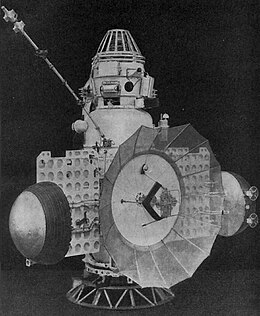


The Russian Zond 1
| |
| Names | Zond 3MV-1 No. 4 |
|---|---|
| Mission type | Venus lander |
| Operator | OKB-1 |
| COSPAR ID | 1964-016D |
| SATCAT no. | 00785 |
| Mission duration | 1 month and 21 days |
| Spacecraft properties | |
| Bus | 3MV-1 |
| Launch mass | 890 kg (1,960 lb) |
| Dry mass | 290 kilograms (640 lb) |
| Dimensions | 3.6 m (12 ft) tall 1.1 m (3 ft 7 in) diameter |
| Start of mission | |
| Launch date | April 2, 1964, 02:40; 60 years ago (April 2, 1964, 02:40) |
| Rocket | Molniya 8K78M |
| Launch site | Baikonur LC-1/5 |
| End of mission | |
| Last contact | May 24, 1964 (1964-05-24) |
| Orbital parameters | |
| Reference system | Heliocentric |
| Perihelion altitude | 0.652 AU |
| Aphelion altitude | 1.001 AU |
| Inclination | 3.7° |
| Period | 274 days |
| Flyby of Venus | |
| Closest approach | July 19, 1964 |
| Distance | 100,000 km (62,000 mi) |
|
← program started
Zond 2 →
| |
Zond 1 was a spacecraft of the Soviet Zond program. It was the second Soviet research spacecraft to reach Venus, although communications had failed by that time. It carried a 90-centimetre (35 in) spherical landing capsule, containing experiments for chemical analysis of the atmosphere, gamma-ray measurements of surface rocks, a photometer, temperature and pressure gauges, and a motion/rocking sensor in case it landed in water. An experimental Ion thruster was also carried for evaluation.
At least three previous Soviet planetary probes had been lost due to malfunctions of the ullage rockets (BOZ) on the Blok L stage, but an investigation found that the problem was easily resolved. The spacecraft, a Venera 3MV-1, was launched on April 2, 1964, from Tyuratam and this time the launch vehicle performed flawlessly. During the cruise phase, a slow leak from a cracked sensor window caused the electronics compartment to lose air pressure. This was a serious problem as Soviet electronics relied on vacuum tubes which would overheat without cooling air. An ill-timed command from ground control turned on its radio system while there was still a rarefied atmosphere inside, causing the electronics to short out by corona discharge. Chief Designer Sergei Korolev was upset at the failure of the mission and demanded higher quality control from the OKB-1 Bureau, including X-rays to test for pressure leaks.
By mid-April, the electronics in the main spacecraft had completely failed and all signal transmission ceased, but communication via the lander could still be performed, and space radiation and atomic-hydrogen spectrometer measurements were received. The experimental ion thruster-based attitude control system were also tested but found to operate erratically, possibly due to the loss of pressure in the electronics compartment.[1] The star trackers in the spacecraft were also used to align it for a course-correction burn, but the second one was off by 65 feet per second (20 meters per second). Also one of the star trackers failed, forcing ground controllers to place Zond 1 into a spin-stabilization mode. However, all communications had failed by May 14. It passed 100,000 kilometres (62,000 mi) from Venus on July 14, 1964.
A similar design of landing capsule was used in Venera 3.[2]
Zond missions were presented as engineering tests by the Soviet Union and to an extent at least that may have been the case.[3] Western observers at the time suggested that the name was used as a cover for failed missions in the same manner that Kosmos designations were used for missions that failed to leave Earth orbit.[3] More recently it has been suggested that "Zond" was genuinely the internal program designation for engineering tests but Zond 1 would have been upgraded to Venera had it been more successful.[3] Zond 1 was actually the second craft that was meant to carry the Zond name, but its predecessor failed to leave Earth orbit and was designated Kosmos 21.[3]
| Preceded by None |
Zond program (interplanetary) | Succeeded by Zond 2 |
|
| ||
|---|---|---|
| 3MV based missions |
| |
| Soyuz 7K-L1/L1S |
| |
| Other |
| |
|
| |||||||||||||
|---|---|---|---|---|---|---|---|---|---|---|---|---|---|
| Active missions |
| ||||||||||||
| Past missions |
| ||||||||||||
| Planned missions |
| ||||||||||||
| Proposed missions |
| ||||||||||||
| Cancelled / concepts |
| ||||||||||||
| Program overviews |
| ||||||||||||
| Related |
| ||||||||||||
| |||||||||||||